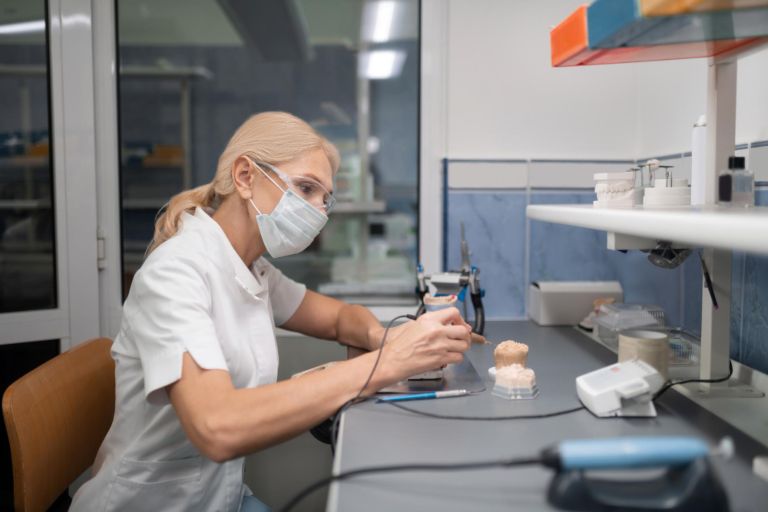Dental prostheses are dental devices used for repairing or replacing damaged or missing teeth. They can help much more than just improve your smile, dental prostheses decrease the risk of gum disease in case of a missing tooth, they make chewing easier and can prevent the jawbone from becoming weak.
In this article, we will explore six types of different dental prosthesis devices so that you can have an informed discussion with your dentist about the best option for you.
For emergency dental care in case of a physical injury or sudden pain, please take a look at our emergency dental treatments.

Dental prostheses are typically divided into two categories: removable and non-removable, but there are also partially removable prostheses. A partial prosthesis, also known as a combined prosthesis, includes both elements of a removable and non-removable prosthesis.
Dental bridges are made from two dental crowns that are connected with a fake tooth or teeth between them. Dental bridges are excellent for repairing adjacent teeth that are missing, decayed or damaged. Bridges can also be used in coordination with implants, known as an implant-supported bridges. Implant-supported bridges are used when natural teeth don’t have enough structural strength to support a dental prosthesis.
Dental crowns are dental prosthetics that resemble caps that fit over the tooth if it is sufficiently damaged by a cavity, injury, or even dental treatments like a root canal. Dental crowns can be made from a variety of materials, including ceramic, metal, or porcelain. The material used for crowns affects their longevity and price to some extent. Dental crown instalment procedures can be either same-day or multi-day. The difference between these procedures is wearing a temporary crown. After preparing the tooth for a crown, you will have to wear a temporary crown. After a couple of weeks, you’ll need to return to the dentist's office and then the long-term crown will be placed on the tooth using a material known as dental cement. If you want, dentists also offer same-day crowns. The preparation process is the same. After that, you just need to wait for the crown to be made and put on your tooth and that's it.
Dental implants are screw-like dental prosthesis devices that are inserted into the jawbone and can be used in a variety of ways with other dental devices. These dental devices are first screwed into the jawbone, and then your dentist can add crowns if only one tooth is affected or missing, or bridges or even full dentures if more teeth are missing. An implant-supported crown is different from a regular crown as it replaces the whole tooth. A type of implant-retained dentures, also known as snap-in dentures, are dentures that use implants to stay in place but need to be removed daily for cleaning.
A total plate is an option if you have completely lost the entire dentition. It is made from two parts: a plastic, nylon, or metal base and the teeth that are fixed to the base. This type of dental prosthesis is fixed by suction. After some time, the fixation begins to weaken, so a denture-fixing cream may be necessary. Even though total plates can be easily put in and taken out, they still offer excellent stability and retention. Total plates also tend to be less expensive than fixed full dentures.
Partial prostheses are meant for people who still have healthy teeth. They are made from a combination of metal and acrylic, but some are made entirely from acrylic which is usually less durable. Having missing teeth can be very damaging for the tissues under and around the missing teeth, causing changes in your physical appearance. Partial prostheses are a great and less-invasive way to keep your gums, jawbone, and facial muscles active and engaged, which helps the further movement of other teeth in your mouth.
A clasp prosthesis is probably the most comfortable type of prosthetic. It has two parts, which are connected by a thin metal arc that fits snugly against the mucosa. They are very comfortable for everyday wear even if they look big. After the procedure, the adaptation period isn’t very long if the clasp structure is made correctly, a month at most. Taking care of a clasp prosthesis is as simple as taking care of natural teeth. You just need to brush and floss twice a day.

